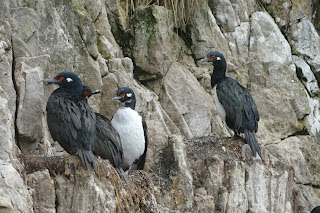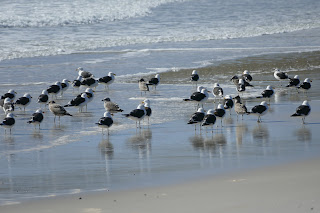It was nice to see
KEP,
Signy was spectacular and
the Falklands incredible. But whilst they, and BI of course, come together to make
such an amazing experience the sunny days were few and far between! So we
needed some sun (34°C of it!! We melted!!) on the way home and the most direct flight home from the
Falklands just happens to be via Ascension Island; so it would’ve been rude not
to visit!
 |
| Taking a stroll through a cloud forest |
Sandy beaches and sun would’ve been enough to relax in for a
few days. But the Ascension is an amazing wildlife island all on its own and so
Lucy, James and I were treated to a final few days of exciting sights together.
 |
| Two weeks we were walking across a glacier, now its a lava flow..... crazy! |
Ascension is famous for its land crabs, and whilst it wasn’t
the season for them in mass numbers we did see quite a few around in the early
mornings coming out after a night of rain. They are real characters lifting
their claws up at anything that goes by.
 |
| Land crabs are feisty little guys |
 |
| Shore crabs make sure not all the attention is given to their land cousins |
It is not just crabs to look out for though, Ascension is a
very important breeding site for green turtles and spending some time in the
late evening sitting on a beach watching them come ashore and dig their nests
to lay eggs is something I will never forget. Alongside the adults laying eggs
are the hatchlings escaping their eggs and sprinting down the shore to the
ocean for the first time. Witnessing the turtles like this is something that
will always amaze me!
 |
| A green turtle swims along (no photos of them nesting at night, but seeing them at any stage is still great) |
A particular highlight for me though was the Galapagos
sharks (yes, they have a range much larger than the name suggests)! I had never
seen sharks, of any species, before so to stand on a pier and see a dozen
sharks swimming around in the shallows was incredible!! Unfortunately though no
photos were possible on this occasion, but you always have a reason for going
back!
 |
| Well, they may not be the sharks, but sergeant major fish in the rockpools are still cool |
Of course, seeing turtles, sharks and crabs was spectacular,
but where there is an island with the right terrain there are seabirds……. and
Ascension has some amazing species! In total we saw 8 different species and
were lucky enough to be able to work with them as volunteers for the Ascensions
Seabird Conservation Scientist, Eliza.
 |
| Switching the sub-antarctic for sweltering heat, anywhere there are seabirds needs investigating! |
 |
| A masked booby colony, the first species we came across |
 |
| The masked booby area stretches across the landscape |
 |
| These birds are closely related to our gannets and you can tell just from the look of them |
 |
| They have a very striking look to them |
 |
| The masked booby nest develops into a circle of small stones surrounded by a circle of poo! |
 |
| Due to the tropical nature of the island, whilst there is a main breeding season the birds can nest at any time. This means that all stages of the breeding cycle can be seen at the same time, from egg incubation... |
 |
| ...to small chicks... |
 |
| ...to fluffy little ones, starting to get as big as their parents... |
 |
| ...to ready to fledge! |
 |
| After the masked booby we saw another species, the brown booby |
 |
| The browns lay 2 eggs as opposed to the 1 of the masked |
 |
| A brown booby flies overhead with an adult frigatebird in the background |
 |
| After seeing the two species of booby the sky became full of another species... |
 |
| ....frigatebirds! |
 |
| The majority of those flying around are chicks taking to the skies for the first time |
 |
| It is amazing to see these birds flying around... |
 |
| ...and just above our heads no less! |
 |
| A frigatebird chick about ready to fledge |
 |
| Some of the chicks are still smaller and fluffy, but the adults are feeding them up well |
 |
| They look funky when fluffy and grow up into very striking birds |
 |
| Growing up in the heat can get quite tough in the middle of the day, but these birds do well |
 |
| An adult female still broods a smaller chick |
 |
| Adult males have a very noticeable red patch to the throat, this inflates to a large size during mating rituals |
 |
| After the frigatebirds we moved on to see some a couple of species of noddy... |
 |
| ...brown noddy... |
 |
| ...and black noddy |
 |
| Looking down towards the base of the cliffs showed us another species as well, the yellow-billed tropicbird! |
 |
| Fairy terns also put in an appearance, darting around the rocks and being very curious coming to see who we are |
 |
| Another day of seabird work, another new species to see, sooty terns! |
 |
| There were tens of thousands of these little birds around, and quite a few were very curious as we walked along the paths around the colonies... |
 |
| ...peering down at us... |
 |
| ...flying past... |
 |
| ...and drifting around getting a good look... |
 |
| ...and making sure we knew they were around! As if the noise weren't enough :) |
 |
| 500 days together and still smiling :) a brilliant zoology team and amazing friends, thank you Luce and Jamins! |
But after so much time away it is amazing to say that I am
back home with family, friends and most importantly my very understanding
girlfriend Nicci. Better yet, the next experience will be working for the
Centre for Ecology and Hydrology on the Isle of May this summer with Nicci as
we join their amazing seabird team researching puffins, shags, gulls,
guillemots……….. and razorbills!!!!!!



























































































